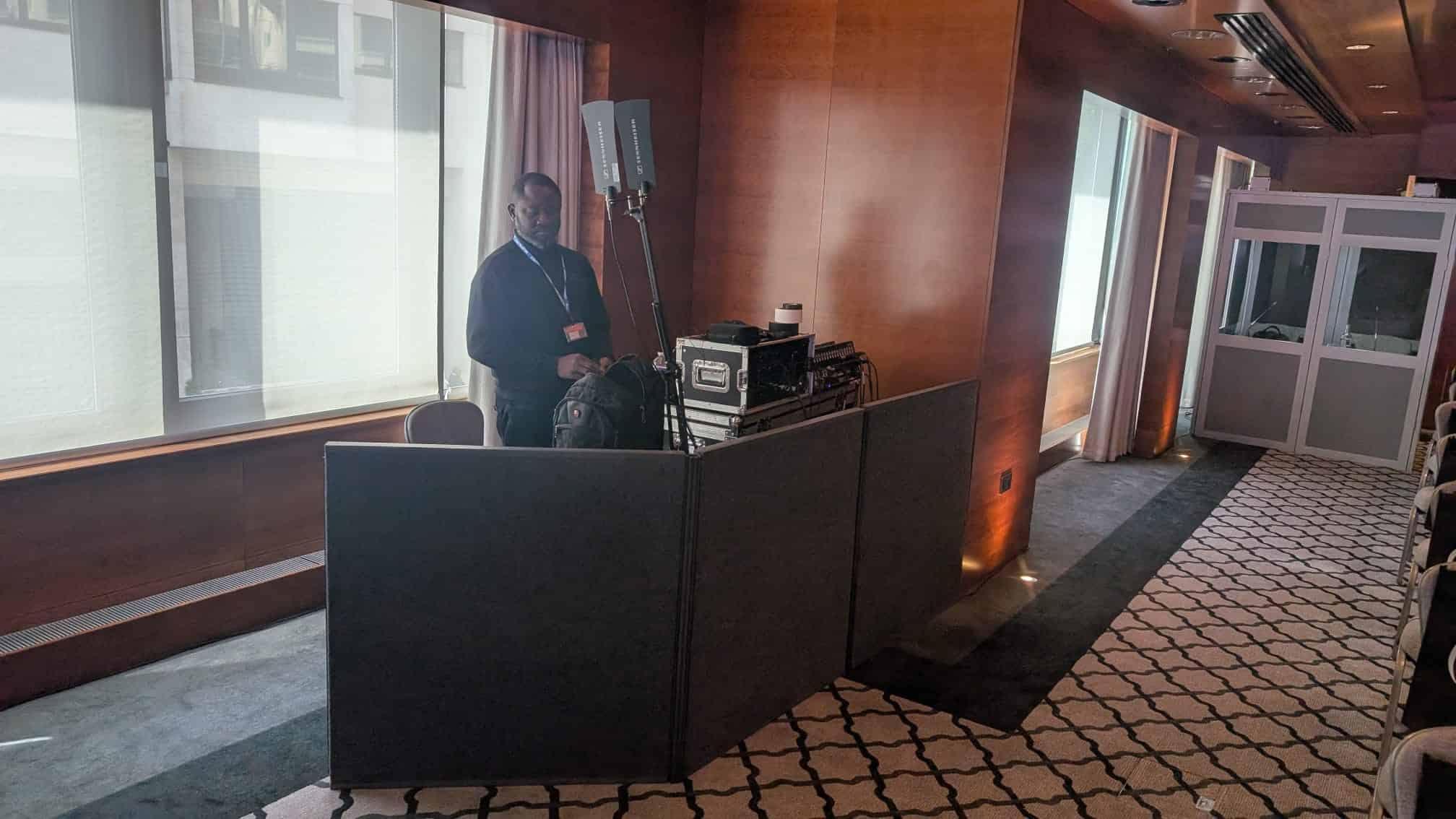The room is filled with voices from every corner of the world. Delegates slip on headsets. A keynote speaker begins. And somehow, everyone hears the message in their own language, almost instantly. It feels effortless. But behind that seamless flow is a highly complex process, simultaneous interpretation.
What most people don’t see is just how demanding this work really is. One interpreter, no matter how skilled, simply can’t sustain that level of focus for long. The mental strain builds quickly, mistakes creep in, and the audience starts missing key points.
That’s why professional events don’t rely on a single interpreter. They rely on two. Working together, alternating, supporting one another. Not as a backup plan, but as an essential part of delivering clear, accurate communication throughout the entire event.
Because when your audience depends on every word, precision isn’t a luxury; it’s the standard.
Why You Absolutely Need Two Interpreters
If you’re planning a conference, webinar, or multilingual meeting, you might wonder why having two interpreters isn’t just standard practice; it’s non-negotiable.
If you want to learn what simultaneous interpretation is, learn here.
Let’s cut to the chase. Here is why using two interpreters for simultaneous interpretation is not just “nice to have,” it is essential.
1. Cognitive Load Is Real And It Is Huge
Simultaneous interpretation is incredibly mentally demanding. Interpreters are listening, understanding, mentally converting the message, and speaking all at the same time. It’s like trying to solve math equations, write poetry, and run a treadmill all simultaneously.
Studies show that after just 20–30 minutes, even the most seasoned interpreters begin to lose accuracy, speed, and concentration. By rotating every 15–30 minutes, two interpreters maintain:
- Accuracy of the message
- Consistent tone and context.
- Professionalism and fluency
Without a break, even the best interpreter will burn out fast, and mistakes in interpretation can lead to serious misunderstandings.
2. One Listens, One Supports
While one interpreter is actively interpreting, the other isn’t simply resting. Instead, they support the process by checking terminology, noting difficult names or figures, flagging errors, and assisting with smooth handovers.
They act like a co-pilot, making sure nothing falls through the cracks. This kind of teamwork is what keeps the interpretation smooth and on point.
3. Avoiding Fatigue = Better Performance
Let us say you have a 90-minute presentation with one interpreter. Imagine this poor soul trying to keep up without pause. You are guaranteed to have:
- Slower delivery
- Possible mistakes
- Monotone voice
- Mental exhaustion
This affects your event’s credibility and audience engagement. You wouldn’t make your keynote speaker talk nonstop for two hours without water, a break, or rest. So why expect that from your interpreter?
With two interpreters swapping out regularly, the energy stays high, the voice remains fresh, and your audience stays fully engaged.
4. Complexity Of Language
Some events cover highly technical or sensitive topics, like medical seminars, legal forums, or scientific symposiums. These subjects require:
- Precise terminology
- Cultural context
- Fast processing
Two interpreters working as a team are much more likely to keep up with jargon and ensure accuracy without delays. One can jot down complex terms while the other interprets, ensuring nothing is missed or misrepresented.
5. It’s The Global Standard And An Industry Requirement
If you ask any professional interpretation service providers or international organisations like the UN, EU, or WHO, they’ll tell you the same thing: two interpreters per language pair is standard.
In fact, many interpreter associations like AIIC require this setup in their code of conduct. Why? Because they know the risks of solo interpretations, which can be the following:
- Inaccurate translations by words or by context.
- They may get burned out easily.
- May lead to a poor audience experience
If you are serious about hosting a professional multilingual event, do it the right way.
6. Unforeseen Tech Or Personal Issues
Let’s be real, life happens, and there can be lots of unforeseen mishaps at the event. Some of the most common mishaps include:
- The interpreter suddenly coughs or loses their voice?
- Is there a technical glitch in the booth?
- Someone has an urgent bathroom break?
Having two interpreters means one can seamlessly continue without skipping a beat. It is your event’s insurance policy against awkward silence or disrupted communication.
What Happens If You Try Using Just One Interpreter?
The simplest answer? It’s risky business.
Let’s say you’re hosting a 3-hour medical webinar for a multilingual audience, and you go with one interpreter. On average, the most experienced simultaneous interpreters can work only for 20-30 minutes max. Thus, halfway through, they are tired, start skipping words or phrases, and get mentally fatigued. That led to a poor audience experience; they might have missed a vital point.
But Won’t Two Interpreters Cost More?
Yes, slightly. But let’s look at it differently. The small additional cost of hiring two interpreters ensures:
- Professional grade quality
- A relatable experience for your audience
- Better accuracy and delivery
- A polished and inclusive event
Trying to cut corners here is like hiring just one camera operator for a three-camera shoot. Sure, you will save a little. But at what cost to quality?
Any event longer than 30 minutes that relies on live translation needs two interpreters.
